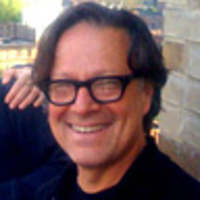The cut-out figures in Thomas Allen’s photographs are period stereotypes. They spring to life from the covers of vintage dime-store novels with playful irony, but an exacting regard for photography’s formal properties is what distinguishes his work from clever illustration. The visible layers between one figure and another are flattened to the surface of the print even as the scene appears in three dimensions. It’s a canny perceptual anomaly that rouses the eye into active comprehension.
Click Image to View Our Gallery

A show of his new work, Epilogue, is on view at Foley Gallery in New York through October 10, his third show at the gallery in five years. Epilogue refers to Allen’s claim that this is the final set of images he will make utilizing vintage paperbacks. A book of his earlier work, Uncovered: Photographs by Thomas Allen, with a foreword by Chip Kidd, was published by Aperture in 2007.
Allen finds most of his source material on a Web site that boasts cover scans of every vintage American paperback before 1960. He downloads his favorite covers and searches online booksellers to locate the cheapest copies of the books. His library now contains more than 300 of these pulp novels. “I don’t read them, though,” he says, because the contents often have little or nothing to do with the covers.
Neither do his pictographic dramas have any resemblance to the covers from which his characters hail. In Distraction, 2006, a Rock Hudson-like private eye sits reading the paper and smoking a cigarette, his gaze aimed at an athletic young man removing his shirt behind him. In fact, both cut-outs come from separate dime-store novels; each man’s gaze had been directed toward a woman. In this narrative, though, “distraction” implies homoerotic desire.
Allen grew up in Detroit and went to Wayne State University, initially as a criminal-justice major before shifting his course of study to art. Law enforcement was something of a family business: Two uncles were police officers and his grandfather was a private detective. No wonder his pictures depict the noir-ish mystique of the detective novel. In Floored, (self-portrait) 2009, for example, a crime scene is portrayed with a boozy broad holding a smoking gun and viewed from the perspective of the felled murder victim.
Given Allen’s Pop treatment of the pulp novel, and the visible stamp of outdated printing techniques on his cardboard figures, I asked Allen if his work had any relationship to the comic-book characters that loomed large in Roy Lichtenstein’s 1960s Pop Art paintings, with printing dots rendered in heightened graphic description. Or whether there is polemical intent to his pictures, as in Laurie Simmons’ 1980s dollhouse narratives. Instead, he cited as his influences Joseph Cornell’s boxes, David Leventhal’s early photographs, Arthur Tress’ series called Teapot Opera and Fishtank Sonata, and the Thorne miniature rooms at the Art Institute of Chicago. “When you get real close to them,” he says about the Thorne pieces, “you feel like you’re part of it. You enter that reality as if you are part of the space.”
Storytelling seems to be the thrill for Allen. “A fabricated reality,” he has called it. He extrapolates from tales that have long settled into mid-century American lore—the cowboy, the detective, the temptress, the hidden romance between doctor and nurse. As a young kid, Allen drew on his children’s books, modifying characters and adding new ones, but he was also taught that books were precious objects and you shouldn’t fold the pages or cut the corners. “But they are just stuff,” he says,” and the idea of taking their original intent and altering it and making something else from them is interesting.”
Allen has recast these old characters in his own photographic reality, and they seem viable within the frame, living and breathing in our suspension of disbelief the way characters are invoked in our minds by a string of words on a page. The dramas enacted by Allen’s cultural has-beens may be hyperbolic, but, isn’t it all in the telling of the tale? The real story of Allen’s work is the formal resolution of his pictures. He makes visual fiction that doesn’t purport to be otherwise, and your eye benefits by going along for the ride.
Plus: Check out Art Beast, for galleries, interviews with artists, and photos from the hottest parties.
Philip Gefter was a picture editor at The New York Times and wrote regularly about photography for the paper. His book of essays, Photography After Frank, was recently published by Aperture. He is producing a feature-length documentary on Bill Cunningham of the Times, and working on a biography of Sam Wagstaff.




